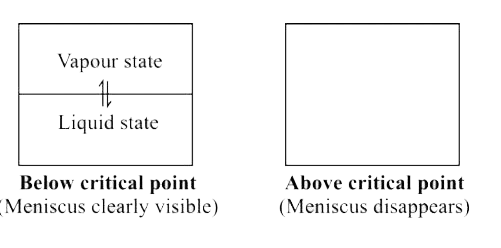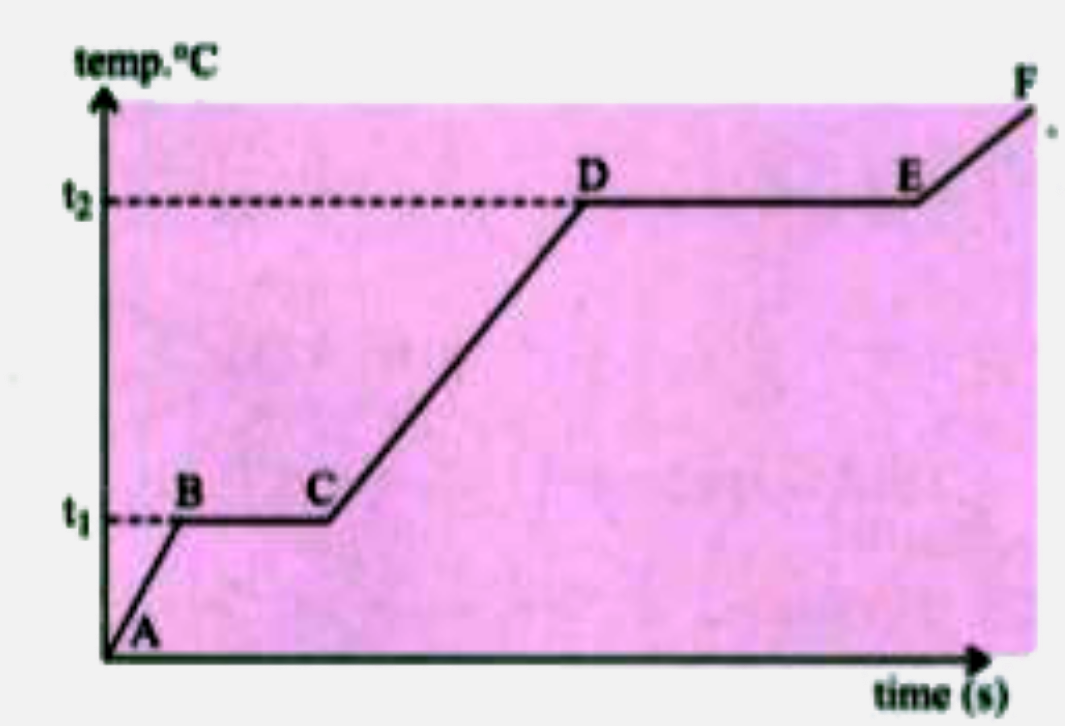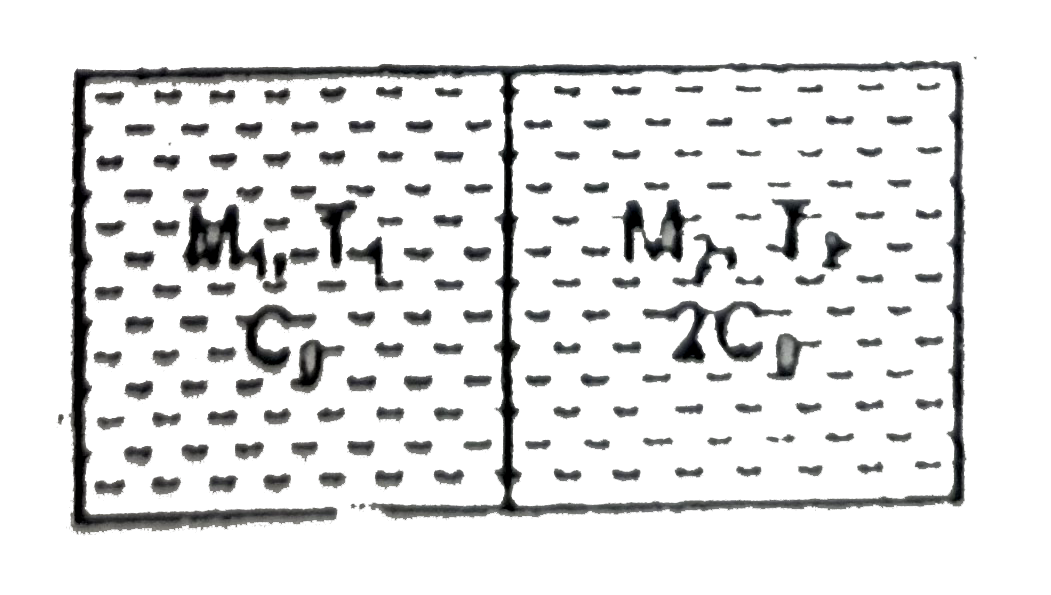Why does the boundary between liquid phase and gaseous phase disappear on heating a liquid upto critical temperature in a closed vessel ? In this situation what will be the state of the substance ?
In a closed vessel, it is essential to know that below the critical point (i.e., critical temperature and critical pressure), the surface of separation between the liquid and its vapour is clearly visible. As we approach towards the critical point, the density of the liquid decreases while that of the vapour increases due to compression.
At the critical point, the densities of the liquid and that of the vapour becomes equal and the surface of separation disappears i.e., the liquid and the gaseous state become non separable. In other words, the meniscus is no longer visible.
This fluid which is now a homogenous mixture is called supercritical fluid. Hence, any fluid above its critical temperature and pressure is called a supercritical fluid.
These supercritical fluids dissolve many organic substances. They are used for quick separation of a mixture into its components. e.g., CO2 above 31.1∘C and above 600 bar pressure has a density of about 1g/cm3.It is used to dissolve out caffeine from coffee beans as it is a better substitute than chlorofluorocarbons which are harmful for the environment.

Topper's Solved these Questions
- STATES OF MATTERBOOK - VMC MODULES ENGLISHCHAPTER - STATES OF MATTEREXERCISE - LEVEL -0 (Short Answer Type-II)
27 Videos
- STATES OF MATTERBOOK - VMC MODULES ENGLISHCHAPTER - STATES OF MATTEREXERCISE - Level-1
75 Videos
- STATES OF MATTERBOOK - VMC MODULES ENGLISHCHAPTER - STATES OF MATTEREXERCISE - IN-CHAPTER EXERCISE-I
10 Videos
- STATES OF MATTERBOOK - VMC MODULES ENGLISHCHAPTER - STATES OF MATTEREXERCISE - IMPECCABLE
50 Videos
- STOICHIOMETRY - IBOOK - VMC MODULES ENGLISHCHAPTER - STOICHIOMETRY - IEXERCISE - JEE Advanced (Archive)
31 Videos
Similar Questions
What happens if a liquid is heated to the critical temperature of its vapour?
View SolutionWhat is the nature of equilibrium between the liquid surface and its vapours in a closed vessel ?
View SolutionEach phase of a material can exits only in certain regions of pressure and temperature . P−T phase diagrams, in which pressure is plotted versus temperature, show the regions corresponding to various phases and phase transformations . P−V diagrams, on the other hand , can be used to study pressure volume relationship at a constant temperature.
If the liquid and gaseous phases of a pure substances are heated together in a closed container, both the temperature and the vapor pressure will increase until a point is reached at which the two phases can no longer be distinguished from one another. The temperature and pressure at which this occurs are called the critical temperature and pressure. Exceeding either of these parameters, by itself ,will cause the gas/liguid phase transition to disappear. if the other variable is then changed as well, while the first variable is maintained above its critical point , a gradual transition will occur between the gaseous and liquid phases, with no clear boundary.(The liquid and solid phases, on the other hand , maintain a distinct boundary at all pressure above the triple point). Shown in figure is a combined P−T phase diagram for material A and B.
_E01_196_Q01.png)
Which is true about the substance in figure?
View SolutionEach phase of a material can exits only in certain regions of pressure and temperature . P−T phase diagrams, in which pressure is plotted versus temperature, show the regions corresponding to various phases and phase transformations . P−V diagrams, on the other hand , can be used to study pressure volume relationship at a constant temperature.
If the liquid and gaseous phases of a pure substances are heated together in a closed container, both the temperature and the vapor pressure will increase until a point is reached at which the two phases can no longer be distinguished from one another. The temperature and pressure at which this occurs are called the critical temperature and pressure. Exceeding either of these parameters, by itself ,will cause the gas/liguid phase transition to disappear. if the other variable is then changed as well, while the first variable is maintained above its critical point , a gradual transition will occur between the gaseous and liquid phases, with no clear boundary.(The liquid and solid phases, on the other hand , maintain a distinct boundary at all pressure above the triple point). Shown in figure is a combined P−T phase diagram for material A and B.
_E01_195_Q01.png)
If heat is added to solids A and B , each in a container that is open to the atmosphere :-
View SolutionThe diagram below shows the change of phases of a substance on a temperature vs time graph on heating the substance at a constant rate.

What is the boiling and melting point of the substance ?
View SolutionA thermally insulated vessels contains two liquids with initial temperature T1 and T2 and specific heats C0 and 2C0, separted by a non conducting partition. The partition is removed, and the difference between the initial temperature of one of the liquids and the temperature T established in the vessel turns out to be equal to half the difference between the initial temperatures of the liquids. Determine the ratio of M1/M2 of the masses of the liquids.

View SolutionA substance on heating, undergoes (i) a rise in its temperature, (ii) a change in its phase without change in its temperature. In each case, state the change in energy of molecules of the substance.
View SolutionHeat supplied to a solid changes it into liquid. What is this change in phase called ?
View SolutionWhat is the state of dispersed phase and the dispersion medium (solid, liquid or gas) in smoke, mist, milk and gels?
View SolutionA "flow calorimeter" is used to measure the specific heat of a liquid. Heat is added at a known rate to a stream of the liquid as it passes through the calorimeter at known rate, then a measurement of the resulting temperature difference between the in flow and the out flow points of the liquid stream enables us to compute the specific heat of the liquid. A liquid of density 0.85 g/cm3 flows through a calorimeter at the rate of 8.0 cm3/s. heat is added by means of a 250 watt electric heating coil, and a temperature difference of 15∘C is established in steady state conditions between the in flow and out flow points.
Q. Specific heat of the liquid is
View Solution
